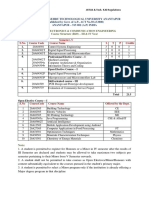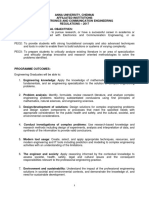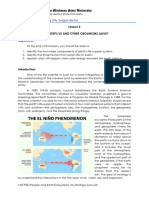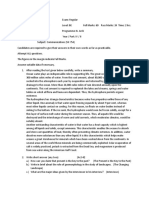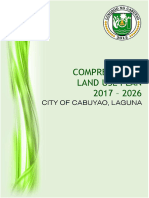CNR Module-4 Notes
Uploaded by
Devu DevugowdaCNR Module-4 Notes
Uploaded by
Devu DevugowdaModule 4 Conservation of Natural Resources (21CV654)
CONSERVATION OF NATURAL RESOURCES (21CV654)
MODULE - 4
Biodiversity: Introduction, Flora and Fauna, Importance of biodiversity, Economic values-
medicinal plants, drugs, fisheries biogeochemical cycling. Threat to biodiversity, natural &
anthropogenic disturbance, habitat loss. Conservation of biodiversity, National parks, wild life
sanctuaries, zoological gardens, gene banks, pollen culture, ecological restoration, social
forestry. Ecosystem: Definition, Types: forest, grass land, marine, desert, wetlands, estuarine,
lotic, lentic. Abiotic & biotic components of eco system.
Introduction:
Biodiversity is the variation among living organisms from different sources including
terrestrial, marine and desert ecosystems, and the ecological complexes of which they are a
part.
Biodiversity describes the richness and variety of life on earth. It is the most complex and
important feature of our planet. Without biodiversity, life would not sustain.
The term biodiversity was coined in 1985. It is important in natural as well as artificial
ecosystems. It deals with nature‟s variety, the biosphere. It refers to variability‟s among
plants, animals and microorganism species.
Biodiversity includes the number of different organisms and their relative frequencies in an
ecosystem.
Biodiversity holds ecological and economic significance.
The values of biodiversity are classified as Ecosystem service value, Ethical Values,
Aesthetic Values, Ecosystem service value, Option value, Social value and Productive use
values.
Types of Biodiversity or Levels of Biodiversity:
There are the following three different types of biodiversity:
1. Genetic Biodiversity
2. Species Biodiversity
3. Ecological Biodiversity or Ecosystem diversity
Navkis College of Engg. Hassan Page 1
Module 4 Conservation of Natural Resources (21CV654)
1. Genetic diversity:
It refers to the variations among the genetic resources of the organisms.
2. Species diversity:
Species diversity refers to the variety of different types of species found in a particular
area.
3. Ecological diversity:
An ecosystem is a collection of living and non-living organisms and their interaction with
each other.
Ecological biodiversity refers to the variations in the plant and animal species living
together and connected by food chains and food webs.
Flora and Fauna:
Flora:
The population of plant life, the natural vegetation including fungi, algae, and
indigenous plants in a particular geographical region or time is called flora. Known as
the “Goddess of the Flower”, flora represents the whole plant kingdom.
There are more than 3000 Indian plant species officially documented as possessing into
eight main floristic regions : Western Himalayas, Eastern Himalayas, Assam, Indus plain,
Ganges plain, the Deccan, Malabar and the Andaman Islands.
Flora is classified and differentiated based on many factors. The best one among them is the
area in which they grow or are found.
Some grow in desert regions or in water, some are found in hilly areas while some are
endemic to a specific geographic location.
According to the place at which they grow. For example, Cactus plants are naturally seen in
deserts. They have adaptations like modified leaves or prickles to preserve water and protect
themselves from predators.
Examples - Manchineel tree, Giant redwood trees, Nepenthes, temperate forests, Oak,
Alpines, Pines, Rhododendron, Deodar, Maples, Bamboos, deciduous forests, evergreen
forests etc.
Navkis College of Engg. Hassan Page 2
Module 4 Conservation of Natural Resources (21CV654)
Fauna:
The population of animal life in a particular region or time represents the Fauna.
„Goddess of fertility‟ is the name given for Fauna and it consists of a wide variety of animal
lives.
Animal kingdom comprises a variety of animal life forms. Hence, the classification of fauna
is much more complex than the floral division.
Fauna meaning is simply referring to all kinds of animals living in a particular habitat.
Examples - Elephants, Bengal Tiger, Lions, Bison, and Rhinoceros, Coral, Southern
Toadlet, Eltham copper butterfly, fish etc.
Importance of Biodiversity:
Biodiversity and its maintenance are very important for sustaining life on earth. A few of the
reasons explaining the importance of biodiversity are:
1. Ecological role: Species of many kinds perform some of the other functions in an
ecosystem. Every organism, besides fulfilling its own needs, also contributes something
useful to different other organisms in the environment. Species capture, store and utilize
energy, produce and decompose organic materials. Thus, they help in soil formation,
reducing pollution, protection of land, water and air resources.
2. Ecosystem services: Biodiversity support the basis of all the ecosystem services on the
planet.
3. Regulating services: Biodiversity regulates the local as well as global climate, manages
the global levels of oxygen, carbon dioxide and other gases, maintains freshwater quality by
vegetation slowing runoff, absorbs carbon by acting as carbon sinks etc.
4. Supporting services: Biodiversity helps in pollination, nutrient cycling as well as
recycling, greenhouse gas reduction by sequestration.
5. Social and cultural services: Biodiversity provides us with aesthetic pleasure. It
provides recreational avenues and rich biological diversity encourages tourism in the region.
Many communities and cultures have co-evolved with the surroundings and the resources
provided by a biologically diverse environment. Hence, it performs an important social role
as well. Important services which are provided by biodiversity are: Recreation and
relaxation Tourism especially ecotourism Art, Design and inspiration Spiritual experiences
Navkis College of Engg. Hassan Page 3
Module 4 Conservation of Natural Resources (21CV654)
and a sense of place.
6. Food web maintenance: Biodiversity helps in maintaining food webs as higher the
diversity of an ecosystem, more complex is going to be the food webs because there are so
many options to eat. Therefore, higher chances of survival of every species are there. This
results in more stable food chains and food webs.
7. Scientific role: Biodiversity help in scientific research, education and monitoring. For
example, research about new genetic materials with the help of gene pools.
8. Religious values: Plants like tulsi, peepal, banyan and animals like cows, ox and elephant
are worshiped.
Economic Values-Medicinal Plants, Drugs, Fisheries and Biogeochemical
Cycling:
Economic values of medicinal plants and drugs:
1. It was estimated that there are 2,50,000 species of plants no Earth in that 14 % - 28 %
plants occurring on Earth had at one time or another been used by some human culture for
medicinal purposes.
2. Due to their characteristic benefits and medicinal value, medicinal plants are gaining
importance worldwide.
3. Medicinal plants are considered as a rich resources of ingredients which can be used in
drug development either pharmacopoeial, non- pharmacopoeial or synthetic drugs.
4. A part from that, these plants play a critical role in the development of human cultures
around the whole world.
5. Moreover, some plants are considered as important source of nutrition and as a result of
that they are recommended for their therapeutic values.
6. Some of these plants include ginger, green tea, walnuts, aloe, pepper and turmeric etc.
Some plants and their derivatives are considered as important source for active ingredients
which are used in aspirin and toothpaste etc.
7. Medicinal plants such as Aloe, Tulsi, Neem, Turmeric and Ginger cure several common
ailments. These are considered as home remedies in many parts of the country.
8. It is known fact that lots of consumers are using Basil (Tulsi) for making medicines, black
tea, in pooja and other activities in their day to day life.
Navkis College of Engg. Hassan Page 4
Module 4 Conservation of Natural Resources (21CV654)
9. It is becoming famous, and people are using herbal therapy as an alternative medicinal
therapy. Because of their increased traditional use and cultural acceptability, these
medicinal plants are greatly admired and also have minimal side effects and thus are
gaining global importance.
10. Apart from the medicinal uses, herbs are also used in natural dye, pest control, food,
perfume, tea and so on.
11. In many countries different kinds of medicinal plants/ herbs are used to keep ants, flies,
mice and flee away from homes and offices. Now a days medicinal herbs are important
sources for pharmaceutical manufacturing.
12. Recipes for the treatment of common ailments such as diarrhoea, constipation,
hypertension, low sperm count, dysentery and weak penile erection, piles, coated tongue,
menstrual disorders, bronchial asthma, leucorrhoea and fevers are given by the traditional
medicine practitioners very effectively.
13. Over the past two decades, there has been a tremendous increase in the use of herbal
medicine; however, there is still a significant lack of research data in this field.
14. Herbal drugs which are cost-effective than synthetic drugs in many cases are being
promoted by most of the developing countries, and they have started discovering and
filing patents on the medicinal plants and their derivatives.
15. These medicinal plant-derived drugs can be formulated by medicine-based industries.
16. Asian countries are very rich in medicinal plant species and are the major exporters of
these plants and their products.
17. These medicinal plants can be popularized and used to improve the economy of low-
income countries of Asia and create livelihoods for its people.
18. Moreover, overexploitation of these medicinal plants should be limited, the valuable
species of high marketing value should be conserved, and their cultivation should be
promoted for future use.
Economic values of Fisheries:
The economic importance of fisheries is as followed:
1. Fishes are caught, processed, raised, and marketed under fisheries. It provides good job
opportunities and self-employment.
2. Culturing fishes on a large scale in ponds, lakes, and reservoirs boost the productivity and
Navkis College of Engg. Hassan Page 5
Module 4 Conservation of Natural Resources (21CV654)
economy of the nation.
3. Fishes are a source of nutritious food as they are rich in proteins, vitamins (A, D, and K),
carbohydrates, fats, and minerals.
4. They also yield a number of by products that hold commercial value.
5. The by-products obtained from fishes include fish oil, fish meal, fertilizers, fish guano,
fish glue, and isinglass, which are widely used in paints, soaps, oils, and medicines.
6. Prawns and lobsters have a market value all over the world.
Economic values of biogeochemical cycling:
1. Biogeochemical cycles mainly refer to the movement of nutrients and other elements
between biotic and abiotic factors.
2. Biogeochemical cycles help in the regulation of natural elements that are necessary for
living beings, by channeling through physical and biological phenomena.
3. It acts as a recycling procedure in nature.
4. These cycles demonstrate the way in which the energy is used. Through the ecosystem,
these cycles move the essential elements for life to sustain.
5. They are vital as they recycle elements and store them too, and regulate the vital elements
through the physical facets.
6. These cycles depict the association between living and non-living things in the ecosystems
and enable the continuous survival of ecosystems.
7. It is important to comprehend these cycles to learn their effect on living entities.
8. Some activities of humans disturb a few of these natural cycles and thereby affecting
related ecosystems.
9. A closer look at these mechanisms can help us restrict and stop their dangerous impact.
Threat to Biodiversity:
Some of the main threats to biodiversity or causes of biodiversity are:
1. Human Activities
2. Extinction
3. Habitat Loss
4. Overexploitation
5. Pollution
Navkis College of Engg. Hassan Page 6
Module 4 Conservation of Natural Resources (21CV654)
6. Invasive Species
7. Climate Change
8. Deforestation
9. Desertification
10. Increasing Wildlife Trade
11. Poaching and Over hunting
12. Dams
13. Urbanisation
14. Agriculture
15. Forest fires
16. Natural disasters
17. Mining
1. Human Activities:
Human activities are causing a loss of biological diversity among animals and plants globally
estimated at 50 to 100 times the average rate of species loss in the absence of human activities.
Biodiversity loss can result from a number of activities, including:
a) Habitat conversion and destruction;
b) Over-exploitation of species;
c) Disconnected patches of original vegetation; and
d) Air and water pollution.
2. Extinction:
Extinction is the global loss of a species. Five mass extinctions have occurred in geological
history, and extinction rates were particular high during these events. Earth is currently
experiencing a sixth mass extinction, which is driven by human activities.
3. Habitat Loss:
Habitat loss includes habitat destruction, altering the physical environment such that a species
can no longer live there, and habitat fragmentation, which involves dividing a habitat into
discontinuous patches.
4. Overexploitation:
Overexploitation involves removing organisms at a faster rate than they can be replenished.
Examples include the poaching of elephants, unsustainable hunting for bush meat, overfishing,
Navkis College of Engg. Hassan Page 7
Module 4 Conservation of Natural Resources (21CV654)
and overcollection of slow-growing plants and fungi.
5. Pollution:
Pollution is the release of harmful chemicals or other materials into the environment. Some types
of air pollution results in acid deposition and climate change. Nutrient pollution of water bodies
due to fertilizer overuse results in eutrophication.
6. Invasive Species:
Invasive species are those occurring outside of their historical distribution that cause ecological
and/or economic harm. Invasive species can overpredate or outcompete native species,
sometimes causing their extinction or extirpation. Examples of invasive species include the
Asian carp, zebra mussels, Bd (which causes a fungal disease in amphibians), purple loosestrife,
and the European starling.
7. Climate Change:
The release of greenhouse gases, like carbon dioxide and methane, when burning fossil fuels for
energy causes climate change. Not only does climate change involve an increase in average
global temperature, but it also results in unpredictable weather patterns. Climate change threatens
biodiversity through a variety of mechanisms and can cause species range shifts, mismatched
biotic interactions, sea level rise, and ocean acidification.
8. Desertification:
Desertification and deforestation are the main causes of biodiversity loss. Both processes are
decisively influenced by the extension of agriculture. The direct cost of deforestation is reflected
in the loss of valuable plants and animal species. Desertification process is the result of poor land
management which can be aggravated by climatic variations.
9. Deforestation:
When forests are cleared or burned, much of this carbon is released into the atmosphere.
According to current estimates, tropical deforestation and burning account for about one quarter
of carbon emissions into the atmosphere from human activities.
10. Increasing Wildlife Trade:
According to Nick Barnes, “Trade is another cause of biodiversity depletion that gives rise to
conflict between North and South.”
Navkis College of Engg. Hassan Page 8
Module 4 Conservation of Natural Resources (21CV654)
OR
Threat to Biodiversity:
It is under threat due to the following reasons:
1. Destruction of habitat by cutting down trees, filling up the wetland, ploughing of grassland
or burning a forest.
2. Population explosion has increased demand for food and shelter. It has led to culture of
single crop (monoculture) that will result in disappearance of some other crops.
3. Industrialisation and urbanisation has changed and destroyed the natural habitat of plants
and animals.
4. Pollution of soil, air and water changes the habitat quality and may reduce or eliminate
sensitive species.
5. Mining activities add to the pollution of air and water and threaten the survival of the
animals in the nearby areas.
6. Construction of dams, roads and railways destroys huge patches of forests, grassland etc.
thus, disturb the biodiversity.
7. Indiscriminate killing of animals for different purposes has resulted in their reduction.
8. Introduction of exotic/foreign species in an area threaten the survival of existing natural
biodiversity; e.g., water hyacinth clogs rivers and lakes and threatens the life of many
aquatic species in our country.
Natural & Anthropogenic Disturbance:
Natural Disturbance:
1. The destruction, degradation and fragmentation of habitats
2. Exploitation of species
3. Pollution
4. Introduction of alien species
5. Climate change
Anthropogenic Disturbance:
Causes of Anthropogenic Activities
1. Human overpopulation
2. Overconsumption
Navkis College of Engg. Hassan Page 9
Module 4 Conservation of Natural Resources (21CV654)
3. Technology
4. Agriculture
5. Manufactured products
6. Energy harvesting and consumption
7. Mining
8. Transport
9. Environmental degradation
10. Ozone depletion
11. Global warming
12. Mass extinction, defaunation and decline in biodiversity
13. Habitat destruction
14. Land degradation
15. Ocean acidification
1. Human overpopulation (or population overshoot) occurs when the ecological footprint of a
human population in a specific geographical location exceeds the carrying capacity of the place
occupied by that group.
The term human overpopulation refers to the relationship between the entire human population
and its environment
2. Overconsumption is a situation where resource use has outpaced the sustainable capacity of
the ecosystem.
3. The applications of technology often result unavoidable and unexpected environmental
impacts.
Environmental impacts caused by the application of technology are often perceived as
unavoidable for several reasons.
4. The environmental impact of agriculture varies based on the wide variety of agricultural
practices employed around the world. Ultimately, the environmental impact depends on the
production practices of the system used by farmers.
5. Manufactured products such as Cleaning agents, Leather, paper, paint, plastics, pesticides,
Pharmaceuticals and personal care products etc contribute to the environment pollution.
6. The environmental impact of energy harvesting and consumption is diverse. In recent years
there has been a trend towards the increased commercialization of various renewable energy
Navkis College of Engg. Hassan Page 10
Module 4 Conservation of Natural Resources (21CV654)
sources.
7. The environmental impact of mining includes erosion, formation of sinkholes, loss of
biodiversity, and contamination of soil, groundwater and surface water by chemicals from
mining processes.
8. The environmental impact of transport is significant because it is a major user of energy, and
burns most of the world's petroleum. This creates air pollution, including nitrous oxides and
particulates, and is a significant contributor to global warming
9. Mass extinction, defaunation and decline in biodiversity
Biodiversity generally refers to the variety and variability of life on Earth, and is represented by
the number of different species there are on the planet. Since its introduction, Defaunation is the
loss of animals from ecological communities.
10. Global warming is the result of increasing atmospheric carbon dioxide concentrations which
is caused primarily by the combustion of fossil energy sources such as petroleum, coal, and
natural gas, and to an unknown extent by destruction of forests, increased methane, volcanic
activity and cement production.
11. Habitat destruction
According to a 2018 study in Nature, 87% of the oceans and 77% of land (excluding Antarctica)
have been altered by anthropogenic activity, and 23% of the planet's landmass remains as
wilderness
12. Land degradation is a process in which the value of the biophysical environment is affected
by a combination of human-induced processes acting upon the land.
13. Ocean acidification is the ongoing decrease the pH of the Earth's oceans, caused by the
uptake of carbon dioxide (CO2) from the atmosphere.
14. Ozone depletion describes two related events observed since the late 1970s: a steady
lowering of about four percent in the total amount of ozone in Earth's atmosphere (the ozone
layer), and a much larger springtime decrease in stratospheric ozone around Earth's polar
regions.
Habitat Loss:
Habitat loss refers to the reduction in the amount of space where a particular species or group of
species can survive and reproduce.
Navkis College of Engg. Hassan Page 11
Module 4 Conservation of Natural Resources (21CV654)
Habitat destruction is the leading cause of biodiversity loss. Habitat loss is a consequence of
human activities such as agriculture, urbanization, deforestation, resource extraction, alteration
of the sea-floor due to trawling (fishing), or the release of pollutants.
Habitat loss can also occur due to environmental changes, such as volcanic eruptions or
tsunamis, or changes in climate or sea level, which today are largely the result of human
activities. Habitat loss can decrease biodiversity and alters species ranges and interactions.
Habitat destruction is currently considered the primary cause of species extinction worldwide.
Environmental factors can contribute to habitat destruction more indirectly. Geological
processes, climate change, introduction of invasive species, ecosystem nutrient depletion, water
and noise pollution are some examples. Loss of habitat can be preceded by an initial habitat
fragmentation.
Main Causes of Habitat Loss:
1. Agriculture: Much of the habitat loss from agriculture was done long ago when settlers
converted forests and prairies to cropland. Today, there is increasing pressure to redevelop
conservation lands for high-priced food and biofuel crops.
2. Land conversion for development: The conversion of lands that once provided wildlife
habitat to housing developments, roads, office parks, strip malls, parking lots and industrial sites
continues, even during the current economic crisis.
3. Water development: Dams and other water diversions siphon off and disconnect waters,
changing hydrology and water chemistry (when nutrients are not able to flow downstream).
During the dry season, the Colorado River has little to no water in it by the time it reaches the
Sea of Cortez.
4. Pollution: Freshwater wildlife are most impacted by pollution. Pollutants such as untreated
sewage, mining waste, acid rain, fertilizers and pesticides concentrate in rivers, lakes and
wetlands and eventually end up in estuaries and the food web.
5. Climate change: The emerging driver of habitat loss is climate change. Wildlife that need the
cool temperatures of high elevations, such as the American pika, may soon run out of habitat.
Coastal wildlife may find their habitat underwater as sea levels rise.
Navkis College of Engg. Hassan Page 12
Module 4 Conservation of Natural Resources (21CV654)
Conservation of Biodiversity:
Biodiversity conservation refers to the protection, upliftment and management of biodiversity
in order to derive sustainable benefits for present and future generations.
The three main objectives of Biodiversity Conservation are as follows-
1. To protect and preserve species diversity.
2. To ensure sustainable management of the species and ecosystems.
3. Prevention and restoration of ecological processes and life support systems.
Biodiversity Conservation Methods
Biodiversity refers to the variability of life on earth. It can be conserved in the following ways:
A. In-situ Conservation or on-site conservation
B. Ex-situ Conservation or off-site conservation
A. In-situ Conservation or on-site conservation:
In-situ conservation of biodiversity is the conservation of species within their natural
habitat.
It means the conservation of genetic resources in natural populations of plant or animal
species. In situ conservation involves the management of biodiversity in the same area
where it is found.
In this method, the natural ecosystem is maintained and protected.
Some of the important advantages of in-situ conservation are as follows:
1. It is a cost-effective and convenient way of biodiversity conservation.
2. Various living organisms can be conserved at the same time.
3. They can evolve better and can easily get adapted to various environmental conditions.
4. In-situ conservation occurs in places like national parks, wildlife sanctuaries, and
biosphere reserves.
Different methods of In-situ conservation include biosphere reserves, national parks, wildlife
sanctuaries, biodiversity hotspots, gene sanctuary, and sacred groves.
B. Ex-situ Conservation or off-site conservation:
Ex Situ Conservation means conservation of life outside their natural habitat or place of
occurrence.
It is the method in which part of the population or the entire endangered species is taken
from its natural habitat which is threatened and breeding and maintaining of these species
Navkis College of Engg. Hassan Page 13
Module 4 Conservation of Natural Resources (21CV654)
take place in artificial ecosystems.
These artificial ecosystems could be zoos, nurseries, botanical gardens, gene banks etc.
The competition for food, water, and space among the organisms is low.
Ex-situ conservation has the following advantages:
1. Essential life-sustaining conditions like climate, food availability, veterinary care can be
altered and are under human control.
2. Artificial breeding methods can be introduced leading to successful breeding and creating
many more offspring of the species.
3. The species can be protected from poaching and population management can be
efficiently done.
4. Genetic techniques can be applied to increase the population of the species and they can
again be reintroduced into the wild.
National Parks:
National parks are areas that aim to protect the natural environment. They are also
involved in public recreation and enjoyment activities.
In a national park, the landscapes and its flora and fauna are present in their natural state.
India is rich in biodiversity. It comprises about 7.6% mammals, 6.2% reptiles, 12.6% birds,
and 6.0% flowering plant species.
The significant terrestrial ecosystem coming along the Indomalayan ecozone consists of
temperate, polar, wet, dry regions for different kind of species to live.
The species include elephant, tiger, cobra, crocodile, apes, sambar deer, spotted deer,
rhinoceros, goats, lions along with different types of flora and faunas.
All these national parks and the wildlife reserves have been recognized by the IUCN or the
International Union for the Conservation of Nature under the second category of protected
areas.
List of National Parks in India:
The Hailey National Park is the first national park in India.
The other national parks in India include:
1. Bandipur National Park in Karnataka
2. Bandhavgarh National Park in Madhya Pradesh
Navkis College of Engg. Hassan Page 14
Module 4 Conservation of Natural Resources (21CV654)
3. Corbett National Park in Uttarakhand
4. Dudhwa National Park in Uttar Pradesh
5. Gir National Park and Sasan Gir Sanctuary in Gujarat
6. Hemis National Park in Jammu & Kashmir
7. Kanha National Park in Madhya Pradesh
8. Kaziranga National Park in Assam
9. Keoladeo Ghana National Park in Bharatpur, Rajasthan
10. Manas National Park in Assam
11. Nagarhole National Park in Karnataka
12. Panna National Park in Madhya Pradesh
13. Periyar National Park in Kerala.
14. Pench National Park in Madhya Pradesh
15. Ranthambore National Park in Rajasthan
16. Sariska National Park in Rajasthan
17. The Great Himalayan National Park in Himachal Pradesh.
Importance of National parks:
The main purpose of a national park is to protect the natural environment of the area and
conservation of biodiversity. Also, to promote education and recreation.
In India, National Parks are IUCN category II protected areas. Preserving our rich natural
diversity is essential to mankind‟s survival on the planet earth.
1. National parks have lots of plants so they play a big part in keeping our environment
healthy.
2. National parks provide a safe home for native plants and animals.
3. They help keep the air and water clean. National parks give us places to enjoy.
Wild Life Sanctuaries:
A wildlife sanctuary is an area where animal habitats and their surroundings are protected
from any sort of disturbance. The capturing, killing and poaching of animals is strictly
prohibited in these regions.
Many species of plants and animals are on the verge of extinction. Such creatures are
conserved in the wildlife sanctuaries.
Navkis College of Engg. Hassan Page 15
Module 4 Conservation of Natural Resources (21CV654)
They aim at providing a comfortable living to the animals. India has beautiful wildlife
sanctuaries, with dense forests, large rivers, high and beautiful mountains.
Many sanctuaries are involved in ecotourism. They offer accommodation, tour guides,
nature walks, etc.
The main objective of establishing a wildlife sanctuary is to educate humans as to how to
treat the animals. The animals are taken care of and allowed to live peacefully in their
natural habitats.
Wildlife Sanctuaries in India:
Sl.No. Name of Wildlife Sanctuaries State
1 Bharatpur Bird Sanctuary Rajasthan
2 Chilika Lake Bird Sanctuary Odisha
3 Chinnar Wildlife Sanctuary Kerala
4 Gir National Park and Wildlife Sanctuary Gujarat
5 Govind Wildlife Sanctuary Uttarakhand
6 Madumalai Sanctuary Tamil Nadu
7 Periyar Wildlife Sanctuary Kerala
8 Bhadra Wildlife Sanctuary Karnataka
9 Dandeli Wildlife Sanctuary Karnataka
Importance of Wildlife Sanctuaries:
There are a number of reasons for establishing wildlife sanctuaries. Some of the reasons are
listed below:
1. The wildlife sanctuaries are established to protect the endangered species.
2. It is quite difficult to always relocate the animals from their natural habitat, therefore,
protecting them in their natural environment is advantageous.
3. Biologist activities and researches are permitted in the wildlife sanctuaries so that they
can learn about the animals living there.
4. Wildlife sanctuaries preserve the endangered species and protect them from humans and
Navkis College of Engg. Hassan Page 16
Module 4 Conservation of Natural Resources (21CV654)
predators.
Zoological Gardens:
Zoological garden also called Zoo or animal park or zoological park, place where wild
animals and, in some instances, domesticated animals are exhibited in captivity.
OR
A zoo is a facility, in which animals are housed within enclosures, cared for, displayed to
the public, and in some cases bred for conservation purposes.
In such an establishment, animals can generally be given more intensive care than is
possible in nature reserves or sanctuaries.
Most long-established zoos exhibit general collections of animals, but some formed more
recently specialize in particular groups. Example primates, big cats, tropical birds, or
waterfowl.
Marine invertebrates, fishes, and marine mammals are often kept in separate establishments
known as aquariums.
The word zoo was first used in the late 19th century as a popular abbreviation for the
zoological gardens in London.
There are more than 800 professionally managed zoos around the world.
Many of these zoos have well-developed captive breeding programmes.
The majority of these gardens are located in urban areas in temperate countries.
One of the disadvantages is the number of species that can be genetically conserved in a
botanical or zoological garden will always be limited because of the available space.
Gene Banks:
Gene Bank a place where plants or plant materials are preserved to conserve the
germplasm.
Gene banks can be either ex situ, where seeds or plant parts are preserved outside their area
of growth, or in situ, where plants, including wild relatives of crops, are maintained in
natural preserves.
They ensure that the genetic resources that support our food supply are both secure in the
long term for future generations and available in the short term for use by farmers, plant
Navkis College of Engg. Hassan Page 17
Module 4 Conservation of Natural Resources (21CV654)
breeders, and researchers.
These collections are important to ensure that crop plants which may contain genes to resist
disease, provide enhanced nutrition, or survive in changing or harsh environments do not
become endangered or extinct over time.
For plants, this is done by in vitro storage, freezing cuttings from the plant, or stocking the
seeds (e.g. in a seed bank).
For animals, this is done by the freezing of sperm and eggs in zoological freezers until
further need.
The gene bank is maintained as a global public good under the International Treaty on Plant
Genetic Resources for Food and Agriculture (ITPGRFA).
In an effort to conserve agricultural biodiversity, gene banks are used to store and conserve
the plant genetic resources.
Types of gene banks
1. Seed bank
A seed bank preserves dried seeds by storing them at a very low temperature.
2. In vitro bank
In this technique, buds, protocorm and meristematic cells are preserved through particular light
and temperature arrangements in a nutrient medium, which is either jellified or in liquid form.
3. Cryobank
In this technique, a seed or embryo is preserved at very low temperatures. This is helpful for the
conservation of species facing extinction. Cryobanks are utilized for the cryoconservation of
animal genetic resources.
Pollen Culture:
Pollen or microspore culture is a technique of production of haploid plants by the culture
of pollen grains obtained from an anther of a plant under the aseptic condition on artificial
media.
Microspore or the immature pollen can be used as the explant to get the haploid plants
directly.
For pollen or microspore culture the flower buds are collected, surface sterilized and the
anther lobes are dissected out from the flower buds as before.
Navkis College of Engg. Hassan Page 18
Module 4 Conservation of Natural Resources (21CV654)
Then the anther lobes are squeezed with the help of a scalpel within a tube or small beaker
to collect the microspore or pollen in nutrient media.
The main disadvantage of anther culture is that the plants or embryos or calling not only
originate from microspore or pollen but may also originate from various other parts of
anther lobes which are diploid tissues.
The following are the advantages:
1. The explants i.e., microspores or pollens are all haploid cells.
2. The sequence of androgenesis can be observed starting from a single cell.
3. The microspores are ideal for uptake, transformation and mutagenic studies, and the
microspores are evenly exposed to chemicals and physical mutagens.
4. Higher yields of plants anther could be obtained.
Ecological Restoration:
Ecological restoration is the process of assisting the recovery of an ecosystem that has
been degraded, damaged or destroyed.
Ecosystems are dynamic communities of plants, animals, and microorganisms interacting
with their physical environment as a functional unit.
In many ecosystems, humans have altered local native populations of plants and animals,
introduced invasive species, converted natural communities to extractive use (such as
agriculture or mining), fouled waters, and degraded soil resources.
These communities can be damaged, degraded, or destroyed by human activity.
Ecosystems are destroyed by such activities as logging, road building, poaching, or
invasions of non-native species. , long-term over fishing or hunting pressure, land clearing,
urbanization, coastal erosion, and mining and these activities ruins the physical
environment.
Ecological restoration focuses on repairing the damage human activities have caused to
natural ecosystems and seeks to return them to an earlier state or to another state that is
closely related to one unaltered by human activities.
Ecological restoration is distinguished from the practice of conservation, which is primarily
concerned with preventing further losses to ecosystems.
The goal of ecological restoration is to return a degraded ecosystem to its historic trajectory,
Navkis College of Engg. Hassan Page 19
Module 4 Conservation of Natural Resources (21CV654)
not its historic condition.
The ecosystem may not necessarily recover to its former state since contemporary
ecological realities, including global climate change, may cause it to develop along an
altered trajectory, just as these same realities may have changed the trajectory of nearby
undisturbed ecosystems.
History plays an important role in restoration, but contemporary conditions must also be
taken into consideration.
Examples of ecological restoration projects:
1. Walker Basin
2. North American eastern deciduous forest
3. Calcareous grasslands
Social Forestry:
The word Social forestry was coined by Westoby and used in the Ninth Commonwealth
Forestry Congress in 1968. India was one of the first countries to have launched social
forestry.
The term was first used in India in 1976 by the National Commission on Agriculture,
Government of India.
Social forestry refers to the management and protection of forests and afforestation on
barren lands with the purpose of helping in the environmental, social and rural
development.
The main goal of social forestry is to grow trees and plantations to meet the growing
needs of people in reference to increased demand for timber, wood, food, fuel, and food
to reduce the pressure and dependency on traditional forest areas.
The practice also aims to protect agriculture from adverse climatic conditions by
improving the environment, increase the natural beauty and increasing the supply of
forest produce for local use.
Types of Social Forestry:
1. Agro-forestry
2. Farm Forestry
3. Extension Forestry
Navkis College of Engg. Hassan Page 20
Module 4 Conservation of Natural Resources (21CV654)
4. Community Forestry
Some of the Major Benefits of Social Forestry:
1. Conservation of Soil – The run-offs from agricultural land often erode the topsoil.
However, this can be reduced via social forestry. Organic matter is added to the soil
through decaying leaves which enrich the soil and increase its moisture holding capacity
2. Increased Biodiversity – Growing of trees in barren lands within the community helps
to increase the biodiversity value. As trees grow larger, the nature of the habitat will
change.
3. Improving Air Quality – Trees act as filters for various pollutants present in the air,
therefore, providing improved air quality and some plants also add to the medicinal uses.
4. Carbon removal – In the fight against global warming effect, trees play an essential role
in the removal of carbon from the environment. Trees use carbon dioxide when growing
and thus, removing it from the environment.
5. Noise reduction – Trees reflect and absorb sound energy reducing the noise pollution.
6. Social Forestry ensures efficient land use and optimization of land resources.
7. Health benefits planting trees to human habitats can contribute to better health and
improved general wellbeing. Trees also absorb atmospheric pollutants such as carbon
dioxide, nitrogen oxides, volatile organic compounds, and particulate matter.
Trees used for social forestry:
The following multipurpose tree species commonly used in social forestry:
Acacia nilotica, Ailanthus excels, Albizzia procera, Albizzia lebbek, Anacardium occidentale,
Bahinea speices, Dalbergia sissoo, Gmelina arborea etc.
Ecosystem:
Definition:
An ecosystem can be defined as a structural and functional unit of ecology in which
different living organisms interact with others and surrounding non-living environments.
In other words, an ecosystem is a chain of interactions between organisms and their
environment.
The term “Ecosystem” was first coined by A.G.Tansley, an English botanist, in 1935.
Navkis College of Engg. Hassan Page 21
Module 4 Conservation of Natural Resources (21CV654)
Types of Ecosystem:
There are different types of ecosystems based on different climates, habitats, and life forms.
However, all such types generally fall into one of the following two categories:
A. Aquatic Ecosystem
B. Terrestrial Ecosystem
A. Aquatic Ecosystem:
Aquatic ecosystems refer to all such ecosystems that are primarily located on or inside water
bodies.
The nature and characteristics of all living and non-living organisms in the aquatic system
are determined based on the environment surrounding their ecosystem. Organisms in these
ecosystems interact with other organisms in aquatic and terrestrial ecosystems.
The aquatic ecosystem is mainly sub-divided into the following types:
1. Freshwater Ecosystem
Navkis College of Engg. Hassan Page 22
Module 4 Conservation of Natural Resources (21CV654)
2. Marine Ecosystem
1. Freshwater Ecosystem:
The freshwater ecosystem is one of the essential ecosystems for humans and other
organisms living on land.
This is because this ecosystem is a source of drinking water. Additionally, it also helps in
providing the necessary energy and water for transportation, recreation, etc.
The freshwater ecosystem is the smallest type of ecosystem among the major types of
ecosystems.
There is usually no salt content in the freshwater ecosystem. Besides, it consists of many
insects, small fish, amphibians, and various plant species.
Plants help provide oxygen through photosynthesis and also provide food for the organisms
living in this ecosystem.
Freshwater ecosystems mainly include lentic, lotic, and wetlands.
a) Lentic Ecosystem (Lake Ecosystem):
Water bodies that are moving slowly or are still in some places come under lentic.
Lake ecosystems are a prime example of lentic ecosystems. For example, ponds, lakes,
pools, etc. Lakes are known as large water bodies and are surrounded by land.
A lake ecosystem includes biotic plants, animals and micro-organisms, as well as abiotic
physical and chemical interactions.
Lentic ecosystems can be compared with lotic ecosystems, which involve flowing
terrestrial waters such as rivers and streams. Together, these two ecosystems are
examples of freshwater ecosystems.
b) Lotic Ecosystem (River Ecosystem):
The term lotic comes from Latin lotus meaning washing.
Water bodies that are moving at a fast pace fall under a lotic. For example, streams and
rivers.
Lotic or flowing ecosystem is river channels and other related aquatic environments
creek, brook, spring, or stream.
They vary in size and shape. It includes small waterfalls to various big sized river water
bodies.
This ecosystem contains two main zones such as pools and rapids. In this case, the pools
Navkis College of Engg. Hassan Page 23
Module 4 Conservation of Natural Resources (21CV654)
are the deeper water bodies where the currents are slower while the rapids are the areas
where the water is fast with clear bottom.
c) Wetlands Ecosystem:
A wetland is an area of land that is either covered by water or saturated with water. The
water is often groundwater, seeping up from an aquifer or spring. A wetland‟s water can
also come from a nearby river or lake. Seawater can also create wetlands, especially in
coastal areas.
The saturation of wetland soil determines the vegetation that surrounds it. Plants that live
in wetlands are uniquely adapted to their watery (hydric) soil. Wetland plants are called
hydrophytes.
Wetlands exist in many kinds of climates, on every continent except Antarctica. They
vary in size from isolated prairie potholes to huge salt marshes. They are found along
coasts and inland..
Wetlands go by many names, such as swamps, peatlands, sloughs, marshes, muskegs,
bogs, fens, potholes, and mires.
d) Estuarine Ecosystem:
An estuary is a place where a river or a stream opens into the sea (mouth of the river).
It is a partially enclosed coastal area of brackish water with one or more rivers or
streams flowing into it, and with a free connection to the open sea.
At the estuaries, freshwater carrying fertile silt and runoff from the land mixes with the
salty sea water.
Examples of estuaries are river mouths, coastal bays, tidal marshes, lagoons and
deltas.
Estuaries are formed due to rise in sea level, movement of sand and sandbars, glacial
processes and tectonic processes.
Estuaries are greatly influenced by tidal action. They are periodically washed by sea
water once or twice a day based on the number of tides.
In some narrow estuaries, tidal bores are significant. Tidal bores cause great damage to
the estuarine ecology.
Navkis College of Engg. Hassan Page 24
Module 4 Conservation of Natural Resources (21CV654)
2. Marine Ecosystem:
Marine ecosystems are usually characterized by the presence of salt content. These
ecosystems have a higher salt content than the freshwater ecosystem. Moreover, they are
known as the largest type of ecosystem on Earth.
It usually includes all the oceans and their parts. Besides, marine ecosystems have a
distinctive flora and fauna, which support greater biodiversity than freshwater ecosystems.
This type of ecosystem is essential for both marine and terrestrial environments.
In particular, this ecosystem includes salt marshes, lagoons, coral reefs, estuaries, intertidal
zones, mangroves, seafloor, and deep seas.
Salt marshes, mangrove forests, and sea-grass meadows are said to be among the most
productive ecosystems.
B. Terrestrial Ecosystem:
Terrestrial ecosystem refers to all such ecosystems which are mainly located on land.
Although the presence of water in these ecosystems is measured, they are entirely land
based and exist on land.
More specifically, a low and sufficiently needed amount of water is located in terrestrial
ecosystems.
The low amount of water separates these ecosystems from aquatic ecosystems. Besides,
terrestrial ecosystems typically have temperature fluctuations in both seasonal and diurnal
climates.
It is also a specific factor that makes these ecosystems different from aquatic ecosystems in
similar environments.
Furthermore, the availability of light is somewhat higher in terrestrial ecosystems than in
aquatic ecosystems.
Due to entirely different light availability and temperature in terrestrial ecosystems, they
have diverse flora and fauna. Terrestrial ecosystems include various ecosystems distributed
around different geological zones.
Terrestrial ecosystems are mainly classified into the following types:
1. Forest Ecosystem
2. Grassland Ecosystem
3. Tundra Ecosystem
Navkis College of Engg. Hassan Page 25
Module 4 Conservation of Natural Resources (21CV654)
4. Desert Ecosystem
5. Mountain Ecosystems
1. Forest Ecosystems:
A forest ecosystem is an ecosystem where many organisms live together with the
environment's abiotic components.
There are much different flora and fauna in this ecosystem. This usually means that the
forest ecosystem has a high density of living organisms that live with non-living abiotic
elements.
The forest ecosystem usually includes various plants, microorganisms, animals, and other
species.
Forests are significant carbon sinks and participate in controlling and balancing the overall
temperature of the Erath.
Changes in the forest ecosystem affect the entire ecological balance, and severe changes or
destruction of forests can also kill the whole ecosystem.
Forests are generally classified into tropical deciduous forests, tropical evergreen forests,
temperate deciduous forests, temperate forests, and Taig.
2. Grassland Ecosystems:
Grassland ecosystems are referred to as those ecosystems where the number of trees is low.
These ecosystems mainly consist of grasses, shrubs, and herbs. That means grasses are the
primary vegetation in these ecosystems.
Grassland ecosystems are commonly situated in both the tropical and temperate regions.
They are home to various grazing animals, insectivores, and herbivores.
Examples of these ecosystems include the savanna grasslands and temperate grasslands.
3. Desert Ecosystems:
Desert ecosystems exist worldwide and cover about 17 percent of desert areas. These are
areas where annual rainfall is usually measured less than 25 mm. Due to fewer trees and
land of sand, sunlight intensifies in these ecosystems.
This is why these ecosystems have incredibly high temperatures and low availability of
water. However, the nights are quite cold.
The Desert ecosystem has unique flora and fauna. Plants grow with small amounts of water
and conserve water's possible amount in their leaves and stems.
Navkis College of Engg. Hassan Page 26
Module 4 Conservation of Natural Resources (21CV654)
For example, the spiny-leafed cactus is a type of desert plant that has the characteristic of
storing water using a stem.
Similarly, animals are also adopted to the condition of desert ecosystems. Some common
animals are camels, reptiles, a diverse range of insects and birds.
4. Tundra Ecosystems:
Tundra is the treeless environment of the Arctic Circle.
The tundra region refers to the lower altitudes of polar areas. Most of the time in a year, the
land in this region is covered with snow, which makes the survival very tough this is the
reason for the limited flora & fauna found in this kind of ecosystem.
5. Mountain Ecosystems:
As the name suggests, the mountain ecosystem is characterized by mountainous regions
where the climate is usually cold, and rainfall is low.
Due to these climate changes, these ecosystems have a wide variety of habitats where
various animal and plant species are found.
The high altitude areas of mountainous regions have a cold and harsh climate. This is the
reason why only treeless alpine vegetation is found in these ecosystems.
Animals found in these ecosystems usually have tick fur coats to protect them from cold
climates.
Abiotic & Biotic Components of Eco System:
Components of the Ecosystem or Structure of the Ecosystem:
The structure of an ecosystem is characterised by the organisation of both biotic and abiotic
components.
The structure of an ecosystem can be split into two main components, namely:
1. Biotic Components
2. Abiotic Components
Navkis College of Engg. Hassan Page 27
Module 4 Conservation of Natural Resources (21CV654)
1. Biotic (Living Components):
Biological components refer to all living organisms in the ecosystem.
These components typically include organisms such as animals, plants, humans, and other
microorganisms.
Based on different nutrition, biological components are classified into the following three
categories:
a. Producers:
Producers, also called autotrophs, produce foods for many other organisms using
photosynthesis.
Plants and trees fall under the category of producers.
All other biotic components (organisms measured above producers in a food chain) be
dependent on producers for food directly or indirectly.
b. Consumers:
Consumers, also known as heterotrophs, include organisms that depend on other
Navkis College of Engg. Hassan Page 28
Module 4 Conservation of Natural Resources (21CV654)
organisms for their food needs.
Consumers are divided into primary, secondary, tertiary, and quaternary consumers.
i) Primary Consumers: These organisms feed directly from the producers. They are
herbivorous animals like deer, rabbit, cow, buffalo, and giraffes.
ii) Secondary Consumers: These organisms feed on the primary consumers for their nutrition.
These are carnivorous and omnivorous animals like crows, dogs, cats, snakes.
iii) Tertiary Consumers: These organisms feed on secondary consumers. These are only
carnivores where they only consume meat usually by preying on prey. Eg., lion, tiger, cheetah
iv) Quaternary Consumers: These organisms feed on the tertiary consumers for their nutrition.
Eg; Eagle, which consumes a snake that consumes a frog that consumes a fly.
c. Decomposers:
Decomposers are also known as detritus or saprophytes. These include microbes such as
fungi and bacteria.
Decomposers mainly dependent on dead and rotting organic components for their food
requirements.
They are essential components of the ecosystem because they participate in recycling
nutrients, making them reusable for plants and trees.
2. Abiotic (Non-living Components):
Abiotic components refer to all non-living elements and compounds in the ecosystem,
including climates and climate-components.
Furthermore, the abiotic components are the primary sources of energy and nutrients and set
the stage for proper ecosystem functioning. This basically involves inorganic minerals,
calcium, phosphorus & iron.
The Sun is the primary source of energy for an ecosystem. Other examples of abiotic
components are light, humidity, temperature, gas, water, air, minerals, soil, land, pH,
topography, and various habitats.
Navkis College of Engg. Hassan Page 29
Module 4 Conservation of Natural Resources (21CV654)
Functions of Ecosystem:
Some of the most common functions of the ecosystem are listed below:
1. It helps to regulate all basic ecological processes, manages life systems, and ensures
sustainability.
2. It is responsible for cycling minerals through the biosphere.
3. It maintains and regulates nutrient cycling between abiotic and biotic ecosystem
components.
4. The abiotic components help in the synthesis of organic components that involve the
exchange of energy.
5. It maintains a balance among the various trophic levels in the ecosystem.
Oxygen Cycle:
A Diagrammatic Representation of the Oxygen Cycle
Oxygen cycle plays an essential role in the existence of life on the earth. The oxygen cycle
is a biological process which helps in maintaining the oxygen level by moving through
three main spheres of the earth which are:
Atmosphere
Lithosphere
Navkis College of Engg. Hassan Page 30
Module 4 Conservation of Natural Resources (21CV654)
Biosphere
This biogeochemical cycle explains the movement of oxygen gas within the atmosphere,
the ecosystem, biosphere and the lithosphere. The oxygen cycle is interconnected with the
carbon cycle.
The atmosphere is the layer of gases presents above the earth‟s surface. The sum of Earth‟s
ecosystems makes a biosphere. Lithosphere is the solid outer section along with the earth‟s
crust and it is the largest reservoir of oxygen.
Stages of the Oxygen Cycle:
The steps involved in the oxygen cycle are:
Stage-1: All green plants during the process of photosynthesis, release oxygen back into the
atmosphere as a by-product.
Stage-2: All aerobic organisms use free oxygen for respiration.
Stage-3: Animals exhale Carbon dioxide back into the atmosphere which is again used by the
plants during photosynthesis. Now oxygen is balanced within the atmosphere.
Uses of Oxygen:
The four main processes that use atmospheric oxygen are:
1. Breathing – It is the physical process, through which all living organisms, including
plants, animals and humans inhale oxygen from the outside environment into the cells of
an organism and exhale carbon dioxide back into the atmosphere.
2. Decomposition: It is one of the natural and most important processes in the oxygen cycle
and occurs when an organism dies. The dead animal or plants decay into the ground, and
the organic matter along with the carbon, oxygen, water and other components are
returned into the soil and air. This process is carried out by the invertebrates, including
fungi, bacteria and some insects which are collectively called as the decomposers. The
entire process requires oxygen and releases carbon dioxide.
3. Combustion: It is also one of the most important processes which occur when any of the
organic materials, including fossil fuels, plastics and wood, are burned in the presence of
oxygen and releases carbon dioxide into the atmosphere.
4. Rusting: This process also requires oxygen. It is the formation of oxides which is also
called oxidation. In this process, metals like iron or alloy rust when they are exposed to
moisture and oxygen for an extended period of time and new compounds of oxides are
Navkis College of Engg. Hassan Page 31
Module 4 Conservation of Natural Resources (21CV654)
formed by the combination of oxygen with the metal.
Production of Oxygen:
Plants: The leading creators of oxygen are plants by the process of photosynthesis.
Photosynthesis is a biological process by which all green plants synthesize their food in the
presence of sunlight. During photosynthesis, plants use sunlight, water, carbon dioxide to create
energy and oxygen gas is liberated as a by-product of this process.
Sunlight: Sunlight also produces oxygen. Some oxygen gas is produced when the sunlight reacts
with water vapour in the atmosphere.
Importance of Oxygen Cycle:
As we all know, oxygen is one of the most essential components of the earth‟s atmosphere. It is
mainly required for:
Breathing
Combustion
Supporting aquatic life
Decomposition of organic waste.
Oxygen is an important element required for life, however, it can be toxic to some anaerobic
bacteria (especially obligate anaerobes).
The oxygen cycle is mainly involved in maintaining the level of oxygen in the atmosphere.
The entire cycle can be summarized as, the oxygen cycle begins with the process of
photosynthesis in the presence of sunlight, releases oxygen back into the atmosphere, which
humans and animals breathe in oxygen and breathe out carbon dioxide, and again linking
back to the plants. This also proves that the oxygen occur independently and are
interconnected to each other.
Navkis College of Engg. Hassan Page 32
You might also like
- Rajiv Gandhi Institute of Technology: Electronics and Communication EngineeringNo ratings yetRajiv Gandhi Institute of Technology: Electronics and Communication Engineering9 pages
- KEY Enabling Technologies and Features of LTENo ratings yetKEY Enabling Technologies and Features of LTE19 pages
- Wireless Communications-An EC-701 Semester - 7 Year - 4: S.C.Puri Department of ECE Asansol Engineering CollegeNo ratings yetWireless Communications-An EC-701 Semester - 7 Year - 4: S.C.Puri Department of ECE Asansol Engineering College43 pages
- Renewable Energy Power Plant (Full Notes) - 1-48No ratings yetRenewable Energy Power Plant (Full Notes) - 1-4848 pages
- Internet-of-Things-Arshdeep Bagha-19-51No ratings yetInternet-of-Things-Arshdeep Bagha-19-5133 pages
- JNTUA R20 B.tech - ECE III IV Course Structure SyllabusNo ratings yetJNTUA R20 B.tech - ECE III IV Course Structure Syllabus112 pages
- Wireless Communication 7th Semester ECE - AlkaNo ratings yetWireless Communication 7th Semester ECE - Alka2 pages
- Satellite Communications Question Bank SUB CODE:18EC732100% (1)Satellite Communications Question Bank SUB CODE:18EC7322 pages
- IAT-I Question Paper With Solution of 15EC741 Multimedia Communication Sep-2019-Pappa M, Dr.K.P.Sharmila100% (1)IAT-I Question Paper With Solution of 15EC741 Multimedia Communication Sep-2019-Pappa M, Dr.K.P.Sharmila18 pages
- ELECTRONICS COMMUNICATION SYSTEMS Cie 2 Question BankNo ratings yetELECTRONICS COMMUNICATION SYSTEMS Cie 2 Question Bank2 pages
- (D) Unit-I: Mapping of CO's With PO's/PSO's: Department of Electronics and Communication EngineeringNo ratings yet(D) Unit-I: Mapping of CO's With PO's/PSO's: Department of Electronics and Communication Engineering1 page
- Atria Institute of Technology: QuestionsNo ratings yetAtria Institute of Technology: Questions2 pages
- Ge8076 Professional Ethics in EngineeringNo ratings yetGe8076 Professional Ethics in Engineering19 pages
- Biodiversity Ecosystems Diversity Species "Biological" "Diversity."No ratings yetBiodiversity Ecosystems Diversity Species "Biological" "Diversity."13 pages
- StormGeo Louisiana - 16 08.59N 082 18.43E 2021071321No ratings yetStormGeo Louisiana - 16 08.59N 082 18.43E 20210713215 pages
- LESSON 6 - What Keeps Us and Other Organisms AliveNo ratings yetLESSON 6 - What Keeps Us and Other Organisms Alive7 pages
- Bishan-Ang Mo Kio Park: River RestorationNo ratings yetBishan-Ang Mo Kio Park: River Restoration4 pages
- Unit-Iv Social Issues and The Environment From Unsustainable To Sustainable DevelopmentNo ratings yetUnit-Iv Social Issues and The Environment From Unsustainable To Sustainable Development37 pages
- Normalizing XRF-scanner Data A Cautionary Note On The Interpretation of High-Resolution Records From Organic-Rich Lakes. Lowemark Et AlNo ratings yetNormalizing XRF-scanner Data A Cautionary Note On The Interpretation of High-Resolution Records From Organic-Rich Lakes. Lowemark Et Al7 pages
- Geotechnical Civil Interview Q&A by The Civil TalesNo ratings yetGeotechnical Civil Interview Q&A by The Civil Tales19 pages
- Egzamin Osmoklasisty Przedimki A An The CwiczeniaNo ratings yetEgzamin Osmoklasisty Przedimki A An The Cwiczenia2 pages
- Answers To CES CBT Test Online About Marine Environment Awareness100% (3)Answers To CES CBT Test Online About Marine Environment Awareness41 pages
- Publication 2017 - SNH Commissioned Report 766 - Manual of Terrestrial EUNIS Habitats in ScotlandNo ratings yetPublication 2017 - SNH Commissioned Report 766 - Manual of Terrestrial EUNIS Habitats in Scotland57 pages














